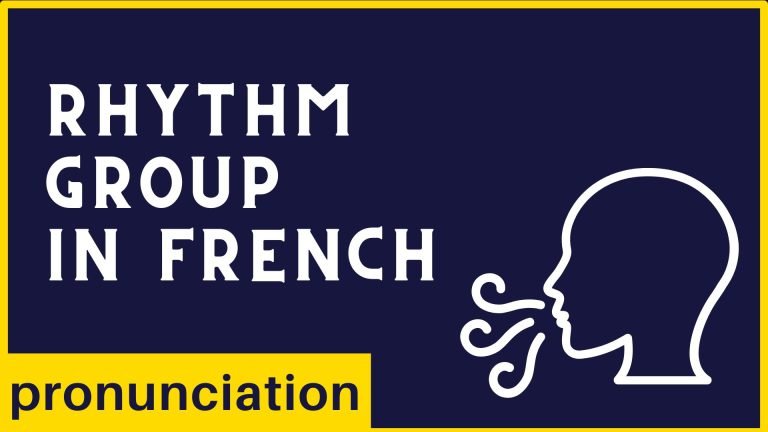How to determine rhythmic groups when learning French?
Published on 17 June, 2024 by Mylene in Guides and Tips ▪

A rhythmic group is a group of words spoken in a single breath, with no pause between words. To identify rhythmic groups in French, one must grasp the underlying structure and rules that define these clusters. In order to acquire the French melody, it is essential to understand where the rhythmic groups are located, since the intonation and accentuation is mainly located on the last syllable of the rhythmic group.
Definition of a rhythm group
In French, words are not pronounced separately. They form sequences called rhythmic groups. Known as “groupes rythmiques”, these groups consist of words that are articulated together in a single breath, typically encapsulating a singular idea.
Example
Comment allez-vous ? is composed of :
- 3 words: comment (1), allez (2), vous (3)
- 5 syllables: [kɔ mɑ̃ ta le vu]
- 1 rhythm group: commentallezvous
S’il vous plait, vous avez l’heure ? is composed of:
- 8 words: s’ (1), il (2), vous (3), plait (4), vous (5), avez (6), l’ (7), heure (8)
- 7 syllables: [sil vu plɛ vu za ve lœʁ]
- 2 rhythmic groups separated by a pause indicated in the transcription by a comma: silvousplait et vousavezlheure

Characteristics of Rhythmic Groups in French
Syntactic Relationship
Words within a rhythmic group are syntactically related, forming a grammatical unit such as a noun phrase, verb phrase, or prepositional phrase.
Length
Rhythmic groups are generally short, typically containing 3 to 4 syllables, though they can extend up to 7 syllables. The length may vary with the speed of speech; faster speech can merge shorter groups into longer ones.
Single Breath
A rhythmic group is pronounced in a single breath, which helps maintain the flow and musicality of the French language.
Stress and Intonation
The final syllable of each rhythmic group is stressed, marked by a slight increase in duration and occasionally a change in pitch.
Read a rhythmic group
Each rhythmic group is pronounced as a single word. A cluster is 1 to 7 syllables long.
Example
- Oh ! (1 syllable)
- Ça va ? (2 syllables)
- Qu’est-ce que c’est ? (3 syllables)
- À tout à l’heure. (4 syllables)
- Aux États-Unis. (5 syllables)
- Absolument parfait ! (6 syllables)
- Je n’ai pas encore fini. (7 syllables)
Find a rhythmic group

A rhythmic group is a group of words that are linked together syntactically (by grammar) and semantically by meaning. The division between some rhythmic groups (such as at the juncture of two clauses in a sentence) may seem obvious, in one-clause sentences, it may be less obvious. A lot depends on how fast you are speaking and on the degree of formality or informality of the conversation.
Example
Je veux manger un gâteau avec de la crème chocolat.
It is possible to make the following divisions:
- Je veux manger | un gâteau | avec de la crème chocolat. (3 rhythm groups)
- Je veux manger un gâteau | avec de la crème chocolat. (2 rhythm groups)
It is impossible to make the following divisions:
- | Je | veux manger un | gâteau avec de la | crème chocolat. There is no grammatical logic, we must try to connect a determiner with the noun that follows, “un gâteau” must be pronounced as a single word.
- | Je veux manger un gâteau avec de la crème chocolat |. It is impossible to make a single group. There are too many syllables. A maximum of 9 syllables should be considered. Je-veux-man-ger-un-gâ-teau-a-vec-de-la-crème-cho-co-lat = 15 syllables.
Here is a list of some general categories for identifying rhythmic groups in French (with some overlap):
1. subject pronoun + (object pronoun +) verb
- Ils sont sortis.
- Elle l’a appelé.
2. preposition + object of the preposition
Nous mangeons — chez des amis.
3. (long) noun phrase as subject
La ville de Dijon — est en Bourgogne.
4. (long) adjectival noun phrase
C’est le garçon — aux longs cheveux noirs.
5. (long) adverb or adverbial phrase
Ils parlent — très poliment.
6. (long) direct object & infinitive phrase
- Nous achetons — les bonnes pâtisseries d’ici.
- Elle préfère — partir plus tôt.
Evolution of the rhythm group
When the flow is fast, the number of rhythmic groups is reduced; each group includes more syllables.
Example
- Je veux | manger un gâteau | avec | de la crème chocolat. (4 groups)
- Je veux manger un gâteau | avec de la crème chocolat. (2 groups)
The number of rhythm groups may vary. Other factors may come into play:
- the hesitation,
- the desire to express oneself clearly,
- the context of communication (on the phone when the line is bad, for example).
To master the French melody, I recommend that you work on intonation and accentuation after mastering the rhythm group.
Applying Rhythmic Groups to Pronunciation
Understanding French Rhythm
The French language is renowned for its unique and charming rhythm, which results from the arrangement and duration of different groups of words and the distribution of sonorities and accents. In French, the rhythm is syllabic, with each syllable having the same duration. This predictable stress pattern makes it easier to determine rhythmic groups in French pronunciation.
Identifying Rhythmic Groups
As mentioned above, a rhythmic group typically corresponds to one idea or sense group and consists of a few syllables, with a maximum of up to 9 syllables. The stress has a demarcating function, making it possible to divide easily recognizable units of meaning. These units are the rhythmic groups.
Applying Stress Patterns
In a rythmic group, the stress in French falls on the final syllable, and the vowel in the final syllable is lengthened and stronger when the tonic accent is used. For example, in the phrases “Le chat“, “Le chat noir“, “Le joli chat noir“, and “Le très joli chat noir“, the bolded syllable is stronger and longer than all the other syllables.
The Path Forward: Rhythmic Groups for Better French
The rhythm of French is a unique and captivating aspect of the language, characterized by a predictable stress pattern that makes it easier to identify rhythmic groups. This syllabic rhythm, where each syllable has the same duration, gives French its distinctive musicality and helps learners develop a sense of fluency and accuracy in speaking the language. Join our online course to master these rhythmic groups and stress patterns, and elevate your French pronunciation to the next level. By understanding and applying these rhythmic groups and stress patterns to French pronunciation, learners can improve their fluency and accuracy in speaking the language.

